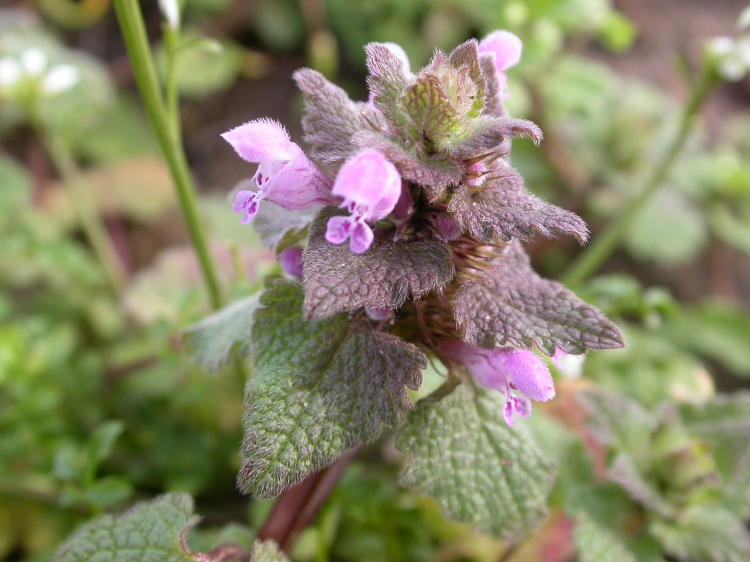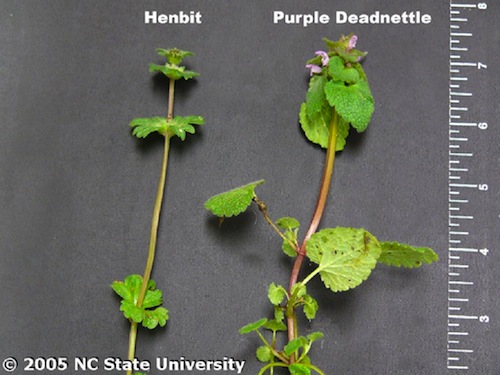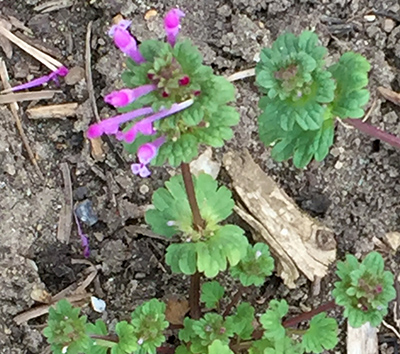Two Winter Weeds on the March
By Gretchen Spencer, Fairfax Master Gardener

Deadnettle
The warm days of March are several weeks away, yet a walk around the neighborhood shows that winter weeds are already on the “march.” This group of weeds, classified as broadleaf winter annual weeds, germinates in late summer and through the fall. During periods of mild winter weather, winter weeds grow and even flower. Their most vigorous growth, however, takes place in the spring. After flowering, and as temperatures increase, these plants die and disappear for the summer. The seeds they have produced will then germinate when temperatures are cooler in the late summer and fall.
Among the weeds classified as broadleaf winter annuals are chickweed (Stellaria media), purple deadnettle (Lamium purpureum), hairy bittercress (Cardamine hirsuta), henbit (Lamium amplexicaule), knawel (Scleranthus annuus), shepherd’s purse (Capsella bursa-pastoris), and corn speedwell (Veronica arvensis). This article will compare and contrast two easily confused winter weeds: purple deadnettle (Lamium purpureum) and henbit (Lamium amplexicaule). Previous articles on this website were devoted to hairy bittercress and to wild onion, the latter a broadleaf perennial weed.
Henbit and deadnettle belong to the mint family (Lamiaceae). They were introduced to this country and are native to northern Africa and Eurasia. They can be found growing in lawns, along roadsides, and in disturbed areas, gardens, and fields. As they bloom early in the spring, they provide food for spring pollinators, and both plants are edible. The common name henbit suggests that the seeds were eaten by chickens. The common name deadnettle refers to the fact that its leaves look like those in the nettle family; however, they have no sting. Hence, the plant was named “deadnettle.” Below is a chart that compares the characteristics of the two plants.
| Henbit | Purple Deadnettle | |
| Leaves | Opposite, rounded to heart-shaped; hairy | Opposite, heart-shaped to triangular; sparsely hairy; upper leaves clearly red or purple |
| Leaf margins | Rounded teeth | Scalloped |
| Petioles (leaf stems) | Lower leaves have petioles; upper leaves sessile (stemless) | All leaves have short petioles |
| Roots | Fibrous | Fibrous |
| Stems | Square; lie on the ground; tips grow upward; green or tinged purple | Square; grows more upright |
| Flowers | Pink to purple tubular flowers; grow in whorls; 2/3 inch long | Purple-red flowers; grow in whorls of 3-6; 1-2 cm long |
| Fruit | Egg-shaped nutlets | Egg-shaped nutlets |
| Reproduction | Roots at nodes and by seed; self-pollinating | By seed only; self-pollinating |

Purple deadnettle (right) and Henbit (left)
The photograph shows some of the similarities and the differences of these two easily confused plants. Both have pink tubular flowers that grow in whorls. Henbit’s rounded, more lobed, sessile leaves clearly grasp the stem; the Latin name amplexicaule means clasping or embracing. Deadnettle’s leaves have petioles, are triangular in shape at the top of the plant, and appear to bend downward and overlap. A photograph shows deadnettle’s purplish-red upper leaves. The leaves also appear to be stacked one upon the other.
Henbit and deadnettle can both spread rapidly. Henbit’s stems can root where they touch the ground. One henbit plant can also produce from 200 to 2,000 or more seeds.

Deadnettle
Purple deadnettle reproduces only by seeds. One deadnettle plant can produce 30,000 seeds! Both of these weeds can be controlled by hand-pulling in small patches, especially after a rainfall when the ground is moist. The fibrous roots and spreading habit make them fairly easy to pull. A good layer of mulch will help to keep weed production down. The best defense against any weed is a vigorous, healthy lawn.
Herbicides may be a more effective method when there is a large area to control. The Virginia Pest Management Guide recommends using a pre-emergent herbicide in the fall, as annual winter weeds germinate when temperatures fall below 75 degrees Fahrenheit. The Guide also recommends using a post-emergent herbicide on broadleaf weeds any time they are actively growing, although the best control is achieved when the weeds are young and before they flower and set seed. Specific herbicide recommendations can be found on the Virginia Cooperative Extension website.

Henbit
While these plants are considered weeds because of their rapid growth and ability to spread in places where they are not wanted, their lovely, delicate flowers and interesting leaves make them fascinating plants to observe. In fact, they appear in books on wildflowers as well. So, whether you consider them wildflowers or weeds, they have many admirable qualities in the wide-ranging and complex botanical world. Enjoy them as they “march” into spring!
Can you tell whether this is henbit or purple deadnettle? If you said, henbit, you are correct! The sessile (stemless), rounded, upper leaves are identifying characteristics.
References
Virginia Tech Weed Identification Guide, Virginia Cooperative Extension
Weeds of the Northeast, by Richard H. Uva, Joseph C. Neal, and Joseph M. DiTomaso, 1997
Henbit, HGIC 232, Clemson Cooperative Extension
Weed of the Month: Purple Deadnettle, by Saara Nafici, Brooklyn Botanic Garden
Purple Deadnettle and Henbit, by Larry Steckel, University of Tennessee Extension W165
A Field Guide to Wildflowers of Northeastern and North-Central North America, by Roger Tory Peterson
Home Grounds and Animals, Pest Management Guide, Virginia Cooperative Extension
… updated 2021